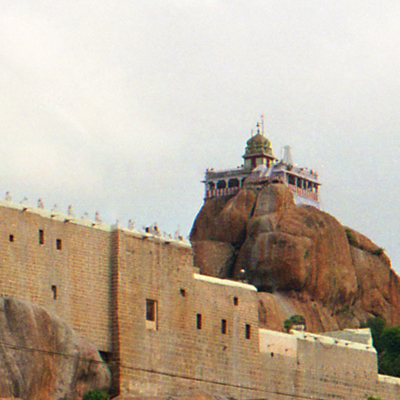Trichy Rock Fort - Tamilnadu

Standing tall against the backdrop of the South Indian sky, the Trichy Rock Fort is more than just a landmark; it's a testament to centuries of history, resilience, architectural brilliance and a famous tourist attraction in Trichy. Perched atop a massive granite rock, this imposing structure has witnessed the rise and fall of empires, wars, and cultural shifts. The fort, built by the Chola dynasty in the 3rd century BCE, was strategically positioned overlooking the Kaveri River, making it a formidable defensive outpost. Over the years, it was further fortified and expanded by the Nayakars, the Marathas, and the British, each adding their own unique architectural elements. Today, the fort stands as a majestic blend of these various historical influences, attracting visitors from near and far. Exploring the fort is a journey through time. Ancient cave temples, dedicated to Lord Shiva and other deities, whisper tales of religious devotion from centuries past. The Ucchi Pillayar Temple, dedicated to Lord Ganesha, is a prominent feature, reached by a steep climb up the rock face. The fort also houses a series of impressive palaces and gateways, each with its own story to tell. The Golden Gate, adorned with intricate carvings, is a stunning example of Nayakar architecture. The massive ramparts, with their strategically positioned bastions, stand as a reminder of the fort's defensive prowess.
History of Trichy Rock Fort
The history of Trichy Rock Fort is closely tied to the history of the Chola dynasty, which ruled over large parts of southern India between the 9th and 13th centuries. The Cholas built several temples and fortifications on the rock, including the Ucchi Pillayar Koil temple, which is dedicated to Lord Ganesha. The temple is famous for its unique architectural style, which combines elements of Dravidian and Hindu temple architecture. The fort was later occupied by the Pallavas, Pandyas, and Vijayanagara Empire, each of whom made their own contributions to the fort and its temples. The fort gained strategic importance during the Carnatic Wars in the 18th century, when it was occupied by the French and British East India Companies. The fort changed hands several times between the French and British, until it finally came under British control in 1790. During the British colonial period, the fort was used as a prison and a storehouse for ammunition and supplies. The British also made some modifications to the fort, including the construction of a clock tower and a European-style mansion. Today, Trichy Rock Fort is a popular tourist destination, attracting visitors from all over the world. The fort offers stunning views of the surrounding city, and its temples are a testament to the rich cultural and architectural heritage of Tamil Nadu.
Architecture of Trichy Rock Fort
The architecture of Trichy Rock Fort is a fascinating blend of ancient and medieval styles, reflecting the rich history of the region. The fort is believed to have been built by the Pallavas in the 6th century, with later additions and modifications made by the Cholas, Pandyas, and Nayakars. The main attraction of the fort is the Ucchi Pillayar Koil, a rock-cut temple dedicated to Lord Ganesha. The temple is located at the top of the rock, accessible by a series of steep steps cut into the stone. The temple's main tower, or gopuram, is adorned with intricate carvings and sculptures depicting various Hindu deities and mythological scenes. The fort itself is surrounded by massive walls and gates, constructed from granite blocks weighing several tons. The walls are punctuated by watchtowers and bastions, providing strategic vantage points for defending the fort. Within the walls, there are several other temples and structures, including a mosque built by the Muslim ruler Hyder Ali.
Special feature Trichy Rock Fort -
One of the most striking features of Trichy Rock Fort is the engineering skill displayed in its construction. The fort's walls and gates were built without the use of mortar, relying instead on the precise fitting of the granite blocks. The steps leading up to the temple are also a remarkable feat of engineering, with each step carved directly into the rock face.
How to reach Trichy Rock Fort
By Air- Trichy airport is the nearest to reach Trichy Rock Fort covering 12 Km
By Train – Trichy railway station is the nearest junction to reach Trichy Rock Fort covering 5 Km
By Road – Driving through Trichy via NH38 is the best way to reach Trichy Rock Fort covering 10 Km